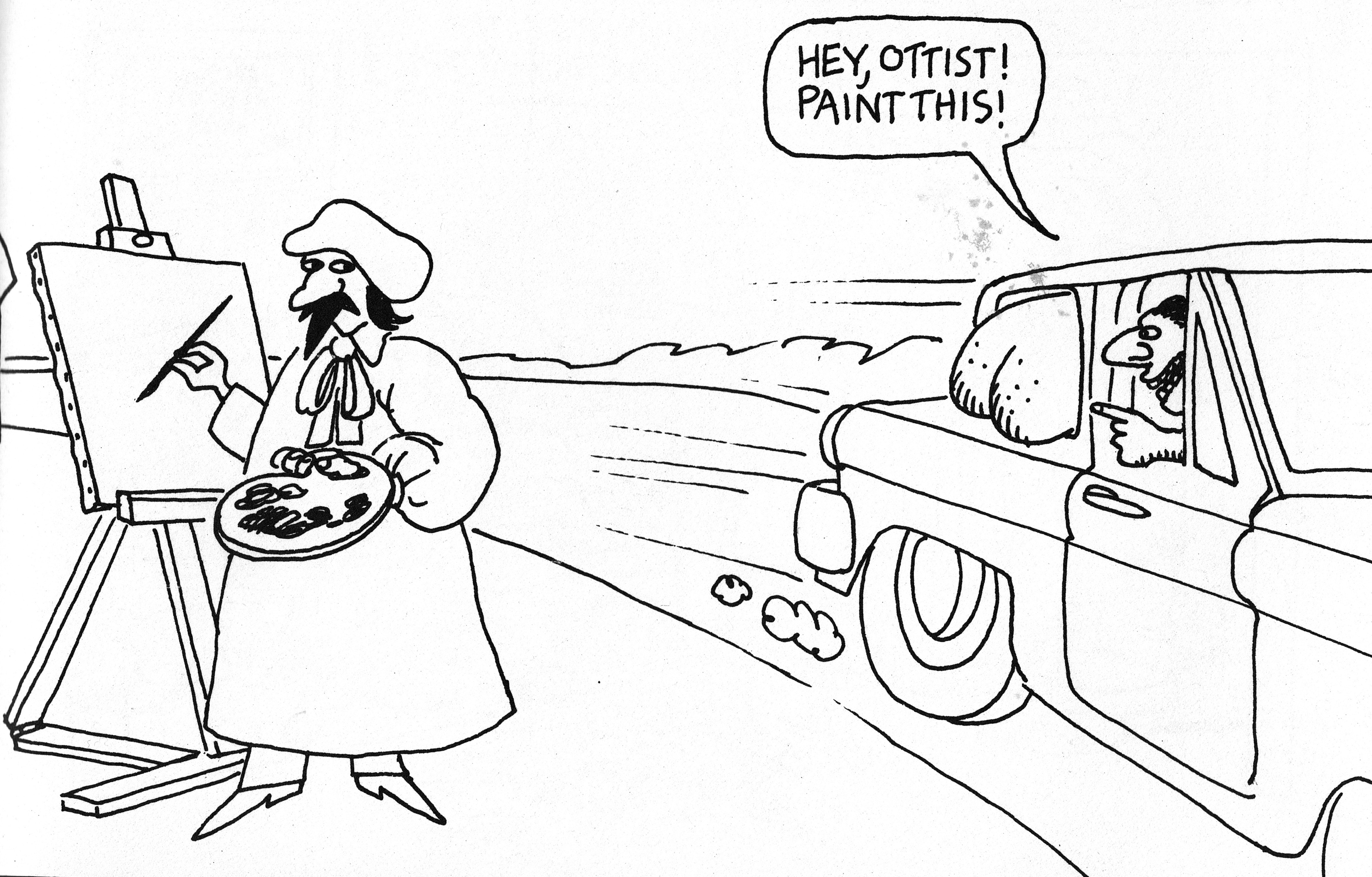Curatorial Proposal - Help me find a Space!

Hap Kliban, Hey Ottist Paint This! c. 1976
The cartoon above, by illustrator Hap Kliban, came to my attention whilst watching Jerry Seinfeld’s ‘Comedian’s in Cars Getting Coffee’. During one episode his guest, and once co-star in the seminal 1990s sitcom Seinfeld, is Julia Louis-Dreyfus AKA Elaine Benes. Jerry delves into her multifarious interests and comedic inspiration and Julia confesses her love for all sides of popular satire. She presents Kliban’s “Hey Ottist, Paint This!” as a curious moment of brilliance, to which Jerry replies, ‘The breadth of quality in the humour that you appreciate is the widest of anyone I’ve ever met...’
The sentiment of the cartoon, and perhaps what Jerry was referring to here, is at first glance the drawing seems at odds with highbrow wit. It reflects a sort of dumb intellectual divide between its three subjects and therefore, any inherent value to a current professional comedian must be negligible.
By contrast, if this cartoon can be taken as an artefact of bygone entertainment, once published in Playboy magazine sometime during the late 1970’s, it is loaded with semantic intrigue for contemporary discussion. Kliban, in much of his output deployed a linguistic bread trail for his audience, and mastered the technique of simultaneously appearing both dumb and profound. To explain: The derogatory gestures from a passing vehicle directed at a caricature of a hobbyist painter complete with a smock and easel. Dressed like a stereotypical amateur not too dissimilar to Tony Hancock’s comedy artisté in ‘The Rebel’ (1961). Is confronted by the buttocks of a passenger in a speeding car and the accompanying punchline in capital letters as if hollered from the front window: ’HEY OTTIST! PAINT THIS!’.
So, what can this possibly offer as a point of departure for a curatorial exercise on the subject of contemporary painting?
To begin to dissect the cartoon’s relevance with the exhibition I am amidst planning I must first establish a few truisms: Firstly, the presence of an ‘O’ instead of an ‘A’ for artist in the speech bubble points us towards a distinct social provenance, potentially, working-class and of Italian-American or Irish-American descent, perhaps evocative of somewhere like Brooklyn in New York given it’s history of prolific migration.
To clarify, I employ any use of the phrase social provenance with due care and attention as it is particularly muddy water to argue whether accents and regional dialects today are means to denote a certain social class as perhaps their increased likelihood may have been some Forty-plus years ago.
And lastly, I am imparting my thoughts on a cartoon from a time I am unable to bear witness to with regards public opinion related to changing artistic endeavours of the period. However it was widely reported that the separation felt by gallery-goers in the 1970’s in response to institutions attempting to contextualise more divergent artistic practices did provoke a certain amount of controversy. Therefore, it is reasonably safe to acknowledge that this public-dissent from the motives and ambitions of Late Conceptualism in the 1970’s bears semblance to the point of view related to the characters in the passing vehicle of Mr. Kliban’s illustration.
Now, returning to my first observation, untangling the heritage of this distinct urban dialect of Brooklyn, New York there are certain parallels with its transatlantic cousin, the ’Cockney’ accent of London and charting a subsequent migration to the outer suburbs of working-class London over the 20th Century and into the 21st. It is possible to suggest that we are witnessing a decline and a deterritorialisation of these once abundant linguistic forms as part of the summarising chapter in the story of gentrification. Specific to the colonisation of artists in the present millennia, the cartoon presents a mediation on the post-dialect or extinction of a language.
What then of the visual clues offered by Mr. Kliban? The easel and side-tacked frame — in so much as the canvas has been nailed onto a support — supposedly an indicative act of a hobbyist painter, from what I was led to believe at art school. OR, what if we go as far to say the cartoon is a portrayal of an artist suffering a postmodern quandary? the blank canvas atop the painters easel, will it remain void indefinitely?Perhaps more tenuously, do we question whether Kliban's character will portray the buttocks he's confronted with in conjunction with the dilemma of ‘representation’ having prominence in the debate concerning painting’s value to a contemporary audience? Or is there some kind of imaginary crossroads in the cartoon’s landscape just beyond our view that stands as a metaphor for the post-modern condition existing as early as the late 1970s?
In any case there is enough hard evidence to form the opinion that largely visible painters of the period (those who have forged some degree of commercial success) scarcely actuated their practice off the back of conscious theoretical affiliation. Or indeed that the art market paid little interest in these ideals one way or another. ‘Language’ often cited as the phrase used by painters referring to their conjured use of space, form, colour, tone etc. is a well trodden path. ‘Hey Ottist, Paint This’ will attempt to unite a cross-generational, International group of painters’ spanning half a century whose common ground is in the invention and recital of their own visual language. In this show painted decisions are constructed; codified, enigmatic, loaded, often formally paired back or figuratively reduced. Connecting artist's for whom the painted object qua sign stands for something other than pure abstract picture making processes and those who process the intrinsic building blocks of picture making.
Thus far, I have approached a number of artists for whom the dialogue seems appropriate and I affectionately note that with some assistance finding the right space and broadening the scope this project will one day be realised.
Images copyright © Judith K. Kliban
Text by James Low
25th July 2020
